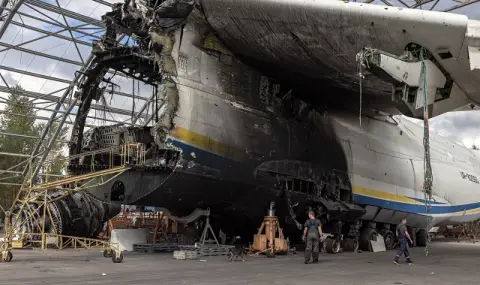It happened again, writes Forbes. For the third day in a row, a Russian drone flew unhindered over a Ukrainian air base. After a longer observation period – about an hour, in this case – Russian missiles arrived, possibly destroying at least one valuable Ukrainian fighter jet.
The crisis in the air defense of the Ukrainian Air Force is deepening, the publication notes. Unless and until the Air Force begins shooting down Russian drones flying over its bases, it will likely continue to lose combat aircraft that it cannot easily replace.
The drumbeat of airfield attacks should panic Ukrainian commanders. On Monday, a Russian drone spotted six Ukrainian Air Force Su-27 fighter jets parked in the open in broad daylight on the runway at the Myrhorod Air Base in northern Ukraine, 160 kilometers from the border with Russia.
Russian ballistic missile "Iskander" immediately took off, destroying two of the precious supersonic fighters.
Something similar happened yesterday. A Russian drone flew over the Ukrainian airbase in Poltava, just east of Myrhorod and also 160 kilometers from the border. After hours of observation, the "Iskander" missile hit – damaging, if not destroying, a Mi-24 combat helicopter of the Ukrainian army.
Today, the Russians attacked the Dolgintsevo air base near Kryvyi Rih, just 80 kilometers from the front line in southern Ukraine. A drone scanned the base and about three missiles — apparently Iskanderi — it rained.
Footage from Russian drone feeds appears to confirm the destruction of two aircraft: one, a non-flying decoy for an Su-25 attack aircraft; the other, an operational MiG-29 fighter.
We can assume that the Su-25 was a decoy because it matched the profile of another Su-25 decoy that the Russians shot down at Dolgintsevo in November, during an earlier round of strikes on Ukrainian air bases that destroyed two MiG- 29 and one operational Su -25.
In total, since the fall, Russian attacks on Ukrainian airfields have disabled two Su-27s, three MiG-29s, one Su-25 and potentially a Mi-24. This is an unsustainable loss rate for a military that may have less than 100 operational combat aircraft and only about 50 warships.
New aircraft are coming from Ukraine's European allies, including 85 Lockheed Martin F-16s and perhaps a dozen Dassault Mirage 2000s. The problem, of course, is that the F-16s and Mirages will also be vulnerable to Russian drone and missile strikes. while parked outdoors in broad daylight.
This is an air defense crisis. Normally, the Ukrainians would protect their most important bases with layers of surface-to-air missiles. But Ukraine's air force and army struggle to simultaneously cover cities, large troop concentrations and front-line bases such as Myrhorod, Poltava and Dolgintsevo airfields.
It is obvious that in prioritizing the air cover of the cities, the Ukrainian armed forces have left their airfields less protected. The Russian drone that monitored Poltava was visible to ordinary Ukrainians on the ground three hours before the "Iskander" missile. to strike. Apparently no one had a way to take it down.
At the same time, aid is coming to Ukraine. The United States just announced a $2.3 billion package that will reportedly include multiple air defense systems, including long-range Patriot missiles and medium-range NASAMS missiles.
But it's possible that these new defenses will end up protecting cities instead of air bases. "You have to make sure you have air defenses to try to protect the areas you invest in,” said US Secretary of State Anthony Blinken.
Forbes: The Russian army is striking Ukrainian military airports, the Air Force is almost completely helpless
It is clear that in prioritizing the air cover of cities, the Ukrainian armed forces have left their airports less protected
Jul 4, 2024 20:44 305
